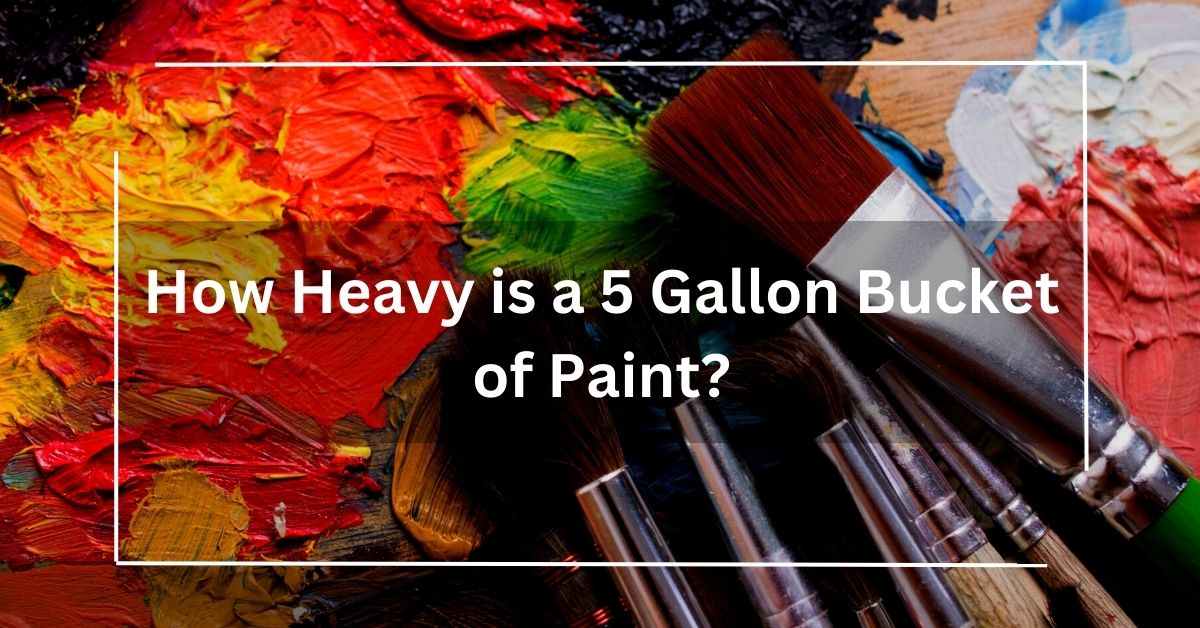Painting projects are a common endeavor for homeowners, DIY enthusiasts, and professionals alike. When tackling large-scale paint jobs, such as painting walls or fences, the question often arises: “How heavy is a 5-gallon bucket of paint?”
The answer isn’t as straightforward as one might think. The weight of a 5-gallon bucket of paint can vary depending on several factors, including the type of paint, its composition, and the material of the container. Let’s dive into the details to find out more.
In this article, we will delve into the factors that influence the weight of a 5-gallon bucket of paint and offer guidance on handling these containers safely.
Understanding the Components: Paint Types and Composition
1. Types of Paint and Their Characteristics
Different types of paint have varying densities due to their composition. Latex-based paints, known for their water-based properties and easy cleanup, tend to be lighter than oil-based paints.
This is because oil-based paints contain solvents that add to their weight. Furthermore, specialty paints like primer or textured paint can also influence the weight of a 5-gallon bucket.
Read: Can You Put Windex On The Car Paint? || All You Need To Know In 2023
2. The Role of Pigments and Additives
Pigments and additives play a significant role in paint composition. Pigments are responsible for color, and additives can enhance qualities like durability, moisture resistance, and adhesion. These components can affect the weight of the paint, albeit marginally.
The Container Matters: Material and Design
1. Plastic vs. Metal Containers
The material of the paint container contributes to the overall weight of a 5-gallon bucket of paint. Plastic containers are generally lighter than their metal counterparts.
Manufacturers often opt for plastic containers due to their cost-effectiveness and ease of transport. Metal containers, on the other hand, are sturdier and can withstand harsh conditions.
2. Additional Packaging and Lid Weight
Paint containers are typically equipped with lids and additional packaging materials for sealing and preservation. These elements might seem inconsequential, but when multiplied by the volume of a 5-gallon bucket, they can contribute to the overall weight.
Crunching the Numbers: Calculating the Weight
1. Average Weight Range
On average, a 5-gallon bucket of latex-based paint weighs around 50 to 60 pounds (22.7 to 27.2 kilograms). This estimation includes the weight of the paint, container, and packaging. For oil-based paints, the weight might range from 55 to 75 pounds (25 to 34 kilograms) due to the added density of oil-based formulations.
2. Specialty Paint Variations
Keep in mind that specialty paints like textured or enamel paints might have different weight ranges. Textured paint, which contains additional solids for creating texture, can be heavier. Enamel paints, which are known for their glossy finish, might also have variations in weight due to their specific formulations.
How Much Does a 5 Gallon Bucket of Paint Cover?
Sure, I’d be happy to help! A 5-gallon bucket of paint can cover around 1,500 to 2,000 square feet of surface area. The coverage depends on factors like the type of paint, the texture of the surface, and the color being used.
Generally, lighter colors might need more coats to cover a darker surface. To calculate the exact coverage for your project, divide the total square footage you need to paint by the estimated coverage per gallon.
Keep in mind that it’s better to have a bit more paint than not enough, to ensure consistent coverage and avoid color variations. Always follow the manufacturer’s guidelines for the specific paint you’re using.
Also Read: Why Do We Hate Painting Resin Models? || Reasons
How Heavy is a 1 Gallon Bucket of Paint?
Certainly! A 1-gallon bucket of paint typically weighs around 10 to 12 pounds (4.5 to 5.4 kilograms). This weight can vary based on the type of paint, its composition, and the brand.
Water-based paints tend to be lighter than oil-based ones. Keep in mind that some specialty paints, like textured or thicker coatings, might be a bit heavier.
If you’re carrying multiple gallons of paint, it’s a good idea to distribute the weight evenly to make it easier to handle.
When transporting paint, ensure the lid is secure to prevent spills and messes. Always check the paint can label for specific weight information as it might vary between products.
20 Litre Paint Bucket Weight in Kg
Certainly! A 20-liter paint bucket typically weighs around 25 to 30 kilograms. However, the exact weight can vary based on factors such as the type of paint, its composition, and the specific brand.
It’s important to keep in mind that different types of paint (water-based, oil-based, etc.) can have varying densities, which will impact the weight of the paint bucket.
If you’re handling a 20-liter paint bucket, make sure to lift it safely and use proper lifting techniques to avoid strain or injury.
Always refer to the label or manufacturer’s information for precise weight details based on the specific paint product you’re using.
How Much Does 5 Gallons of Exterior Paint Weigh
Certainly! Five gallons of exterior paint generally weigh around 50 to 60 pounds. The weight can vary based on the specific paint type, formulation, and brand.
It’s important to note that different paints have different densities affecting their weight. When handling a container with 5 gallons of paint, use proper lifting techniques to avoid strain.
Make sure the container’s lid is secure to prevent spills during transportation. For accurate weight details, consult the label or manufacturer’s specifications of the specific exterior paint you’re using.
Factors Influencing Paint Bucket Weight
The weight of a 5-gallon paint bucket is influenced by multiple factors:
1. Paint Type and Composition
Different types of paint have varying densities due to their unique compositions. For instance, latex paint is generally lighter than oil-based paint. The presence of pigments, solvents, and other additives can also affect the overall weight.
2. Water Content
Water-based paints contain a significant amount of water, which contributes to their weight. The water content can vary among different paint formulations, impacting the weight of the bucket.
3. Brand and Quality
Various paint brands have their formulations, which can lead to differences in weight. High-quality paints might contain more pigments, binders, and other ingredients, increasing the overall weight.
4. Packaging Materials
The material of the paint bucket itself and any additional packaging can add to the weight. Plastic buckets are generally lighter than metal ones, but this can vary by manufacturer and design.
5. Paint Additives
Some paints include additives for specific purposes, such as texture, durability, or anti-mold properties. These additives can affect the weight of the paint.
Expert Insights from SanEcoTec
SanEcoTec, a Canadian cleantech company specializing in water quality solutions, understands the importance of accurate measurements.
Similar to the precise monitoring of water quality, understanding the weight of a 5-gallon paint bucket involves attention to detail.
According to SanEcoTec, factors like the type of paint, its base, and the presence of additives can indeed influence the weight.
Just as their Water Health Index Platform analyzes water quality in real-time, understanding the composition of paint allows for better decision-making when handling and transporting it.
Their comprehensive digital solutions showcase how precise insights can lead to optimal outcomes.
Read: How Long Does Deck Paint Take To Dry? – Complete Guide
FAQs About the Weight of a 5 Gallon Bucket of Paint
1: Can I estimate the weight of my specific paint brand?
While you can make an educated guess based on the type of paint and container material, it’s best to refer to the manufacturer’s specifications for accurate weight information.
2: Does the color of the paint affect its weight?
The color itself doesn’t significantly impact weight. The variation in weight comes from the type of paint and its additives.
3: Can I transport a 5-gallon bucket of paint easily?
Depending on the weight, transporting a 5-gallon bucket of paint can be challenging. Consider using a hand truck or seeking assistance.
4: Why is the weight of oil-based paint higher?
Oil-based paints contain solvents that contribute to their density, making them heavier compared to water-based latex paints.
5: Can I recycle empty paint containers?
Yes, many recycling programs accept empty paint containers. Be sure to check with your local recycling center for guidelines.
6: Is there a way to make carrying heavy paint buckets easier?
Using proper lifting techniques and equipment like hand trucks or dollies can make transporting heavy paint buckets safer and more manageable.
Read: Can You Paint A Metal Roof? – Complete Information About Metal Roof
Conclusion: Weighty Considerations for Painting Projects
In the world of painting, understanding the weight of a 5-gallon bucket of paint is essential for practical reasons. It helps with transportation, storage, and planning for large-scale projects. Remember that the weight can vary based on the type of paint, container material, and any additional packaging. So, the next time you embark on a painting adventure, you’ll be well-equipped with the knowledge to handle those hefty buckets of paint.



